An Ultra-Wide Band Polarization-Independent Random Coding Metasurface for RCS Reduction
Abstract
:1. Introduction
2. Design of the Unit and Theoretical Analysis
3. Design of the PCM Metasurface and Simulations
3.1. Theoretical Analysis of the Designed PCM Metasurface
3.2. RCS Reduction Comparisons with Different Period Length
3.3. RCS Reduction Comparisons with Random Coding and Random Position of Each Unit
4. Experimental Results and Discussion
5. Conclusions
Author Contributions
Conflicts of Interest
References
- Pendry, J.B.; Schurig, D.; Smith, D.R. Controlling electromagnetic fields. Science 2006, 312, 1780–1782. [Google Scholar] [CrossRef] [PubMed]
- Martin, F.; Falcone, F.; Bonache, J.; Marques, R. Miniaturized coplanar waveguide stop band filters based on multiple tuned split ring resonators. IEEE Microw. Wirel. Compon. Lett. 2003, 13, 511–513. [Google Scholar] [CrossRef]
- Smith, D.R.; Pendry, J.B.; Wiltshire, M.C.K. Metamaterials and negative refractive index. Science 2004, 305, 788–792. [Google Scholar] [CrossRef] [PubMed]
- Xu, H.X.; Ma, S.J.; Luo, W.J.; Cai, T.; Sun, S.L.; He, Q.; Zhou, L. Aberration-free and functionality- switchable meta-lenses based on tunable metasurfaces. Appl. Phys. Lett. 2016, 109, 193506. [Google Scholar] [CrossRef]
- Fan, Y.C.; Liu, Z.; Zhang, F.L.; Zhao, Q.; Wei, Z.Y.; Fu, Q.H.; Li, J.J.; Gu, C.Z.; Li, H.Q. Tunable mid-infrared coherent perfect absorption in a graphene metasurface. Sci. Rep. 2015, 5, 13956. [Google Scholar] [CrossRef]
- Yang, Q.; Gu, J.Q.; Wang, D.Y.; Zhang, X.Q.; Tian, Z.; Ouyang, C.M.; Singh, R.J.; Han, J.Q.; Zhang, W.L. Efficient flat metasurface lens for terahertz imaging. Opt. Express 2014, 22, 25931–25939. [Google Scholar] [CrossRef]
- Ma, H.F.; Wang, G.Z.; Kong, G.S.; Cui, T.J. Independent controls of differently-polarized reflected waves by anisotropic metasurfaces. Sci. Rep. 2015, 5, 9605. [Google Scholar] [CrossRef]
- Mo, W.C.; Wei, X.L.; Wang, K.J.; Li, Y.; Liu, J.S. Ultrathin flexible terahertz polarization converter based on metasurfaces. Opt. Express 2016, 24, 13621–13627. [Google Scholar] [CrossRef]
- Liao, Z.; Luo, Y.; Fernandez-Dominguez, A.I.; Shen, X.P.; Maier, S.A.; Cui, T.J. High-order localized spoof surface plasmon resonances and experimental verifications. Sci. Rep. 2015, 5, 9590. [Google Scholar] [CrossRef]
- Pors, A.; Ding, F.; Chen, Y.; Radko, I.P.; Bozhevolnyi, S.I. Random-phase metasurfaces at optical wavelengths. Sci. Rep. 2016, 6, 28448. [Google Scholar] [CrossRef] [Green Version]
- Liu, Z.; Fang, N.; Yen, T.J.; Zhang, X. Rapid growth of evanescent wave by a silver superlens. Appl. Phys. Lett. 2003, 83, 5184. [Google Scholar] [CrossRef]
- Grbic, A.; Eleftheriades, G.V. Overcoming the diffraction limit with a planar left-handed transmission- line lens. Phys. Rev. Lett. 2004, 92, 117403. [Google Scholar] [CrossRef] [PubMed]
- Shelby, R.A.; Smith, D.R. Experimental verification of a negative index of refraction. Science 2001, 292, 77–79. [Google Scholar] [CrossRef] [PubMed]
- Schurig, D.; Mock, J.J.; Justice, B.J.; Cummer, S.A.; Pendry, J.B.; Starr, A.F.; Smith, D.R. Metamaterial electromagnetic cloak at microwave frequencies. Science 2006, 314, 977–980. [Google Scholar] [CrossRef]
- Jia, Y.; Yong, C.; Chen, G.; Rong, G. Broadband Polarization Conversion Metasurface Based on Metal Cut-Wire Structure for Radar Cross Section Reduction. Materials 2018, 11, 626. [Google Scholar] [Green Version]
- Zhou, Y.; Zhang, G.R.; Chen, H.Y.; Zhou, P.H.; Wang, X.; Zhang, L.B.; Zhang, L.; Xie, J.L.; Deng, L.J. Design of phase gradient coding metasurfaces for broadband wave modulating. Sci. Rep. 2018, 8, 8672. [Google Scholar] [CrossRef]
- Cheng, Y.Z.; Wu, C.J.; Ge, C.C.; Yang, J.J.; Pei, X.J.; Jia, F.; Gong, R.Z. An ultrathin dual-band phasegradient metasurface using hybrid resonant structures for backward RCS reduction. Appl. Phys. B 2017, 123, 143. [Google Scholar] [CrossRef]
- Paquay, M.; Iriate, J.C.; Ederra, I.; Gonzalo, R.; Maagt, P.D. Thin AMC structure for Radar Cross-Section reduction. IEEE Trans. Antennas Propag. 2007, 55, 3630–3638. [Google Scholar] [CrossRef]
- Cui, T.J.; Qi, M.Q.; Wan, X.; Zhao, J.; Chen, Q. Coding metamaterials, digital metamaterials and programmable metamaterials. Light Sci. Appl. 2014, 3, 10. [Google Scholar] [CrossRef]
- Moccia, M.; Liu, S.; Rui, Y.W.; Castaldi, G.; Andreone, A.; Cui, T.J.; Galdi, V. Coding metasurfaces for diffuse scattering: Scaling laws, bounds, and suboptimal design. Adv. Opt. Mater. 2017, 5, 19. [Google Scholar] [CrossRef]
- Zhang, L.; Chen, X.Q.; Liu, S.; Zhang, Q.; Zhao, J.; Dai, J.Y.; Bai, G.D.; Wan, X.; Cheng, Q.; Castaldi, G.; et al. Space-time-coding digital metasurfaces. Nat. Commun. 2018, 9, 1. [Google Scholar] [CrossRef] [PubMed]
- Liang, L.J.; Wei, M.G.; Yan, X.; Wei, D.Q.; Liang, D.H.; Han, J.G.; Ding, X.; Zhang, G.Y.; Yao, J.Q. Broadband and wide-angle RCS reduction using a 2-bit coding ultrathin metasurface at terahertz frequencies. Sci. Rep. 2016, 6, 39252. [Google Scholar] [CrossRef] [PubMed] [Green Version]
- Cheng, Q.; Ma, H.F.; Cui, T.J. Microwave antennas and low RCS surfaces based on metamaterials. In Proceedings of the 2015 International Workshop on Antenna Technology, Seoul, Korea, 4–6 March 2015. [Google Scholar]
- Zhang, Y.; Liang, L.J.; Yang, J.; Feng, Y.J.; Zhu, B.; Zhao, J.M.; Jiang, T.; Jin, B.B.; Liu, W.W. Broadband diffuse terahertz wave scattering by flexible metasurface with randomized phase distribution. Sci. Rep. 2016, 6, 26875. [Google Scholar] [CrossRef] [PubMed] [Green Version]
- Dai, H.J.; Zhao, Y.J.; Sun, H.Y.; Chen, J.Q.; Ge, Y.; Li, Z. An ultra-wideband linear polarization conversion metasurface. Jpn. J. Appl. Phys. 2018, 57, 090311. [Google Scholar] [CrossRef]
- Su, P.; Zhao, Y.J.; Jia, S.L.; Shi, W.W.; Wang, H.L. An Ultra-wideband and Polarization-independent Meta- surface for RCS Reduction. Sci. Rep. 2016, 6, 20387. [Google Scholar] [CrossRef] [PubMed]
- Sun, H.Y.; Gu, C.Q.; Chen, X.L.; Li, Z.; Liu, L.; Xu, B.; Zhou, Z. Broadband and broad-angle polarization- independent metasurface for radar cross section reduction. Sci. Rep. 2017, 7, 40782. [Google Scholar] [CrossRef] [PubMed]
- Gao, X.; Han, X.; Cao, W.P.; Li, H.O.; Ma, H.F.; Cui, T.J. Ultra-Wideband and High-Efficiency Linear Polarization Converter Based on Double V-Shaped Metasurface. IEEE Trans. Antennas Propag. 2015, 63, 3522. [Google Scholar] [CrossRef]
- Chen, H.Y.; Ma, H.; Qu, S.B.; Wang, J.F.; Li, Y.F.; Yuan, H.Y.; Xu, Z. Ultra-wideband polarization conversion metasurfaces. In Proceedings of the 2014 3rd Asia-Pacific Conference on Antennas and Propagation, Harbin, China, 26–29 July 2014; pp. 1009–1011. [Google Scholar]



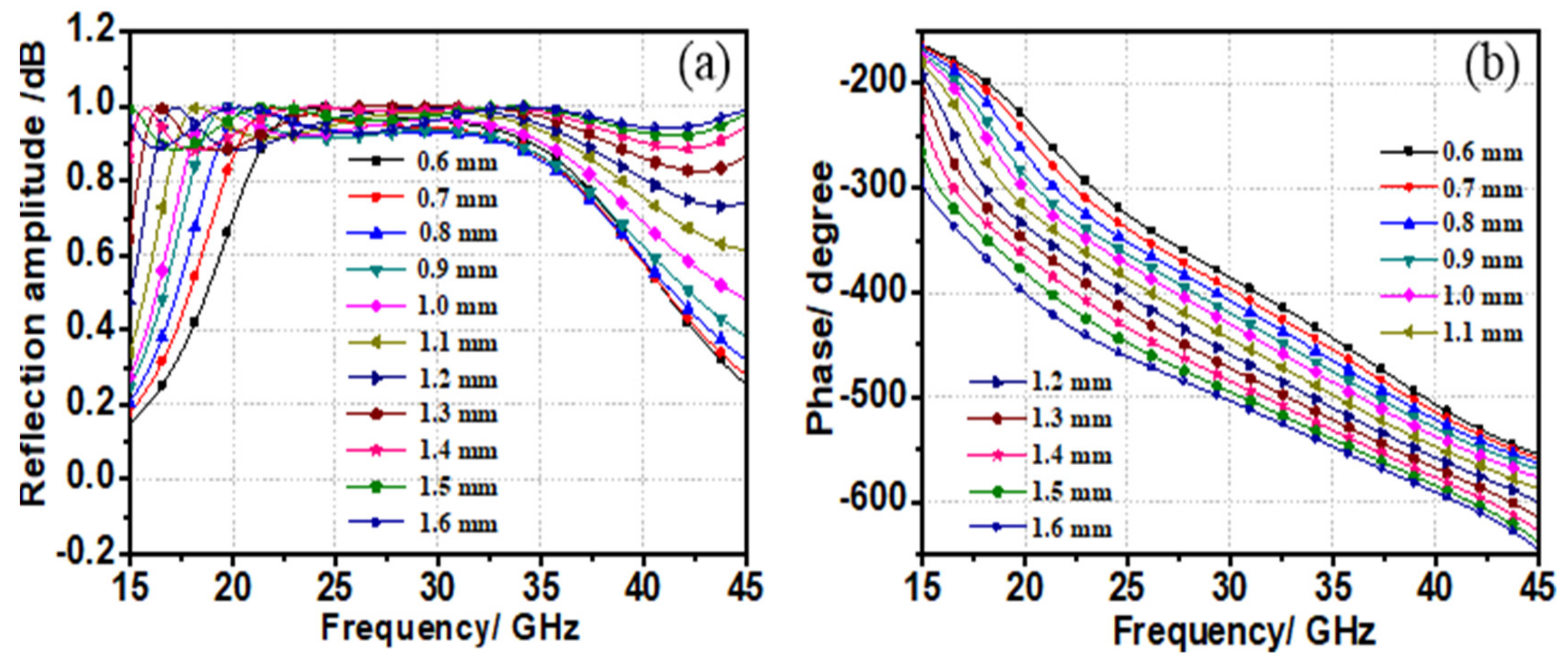


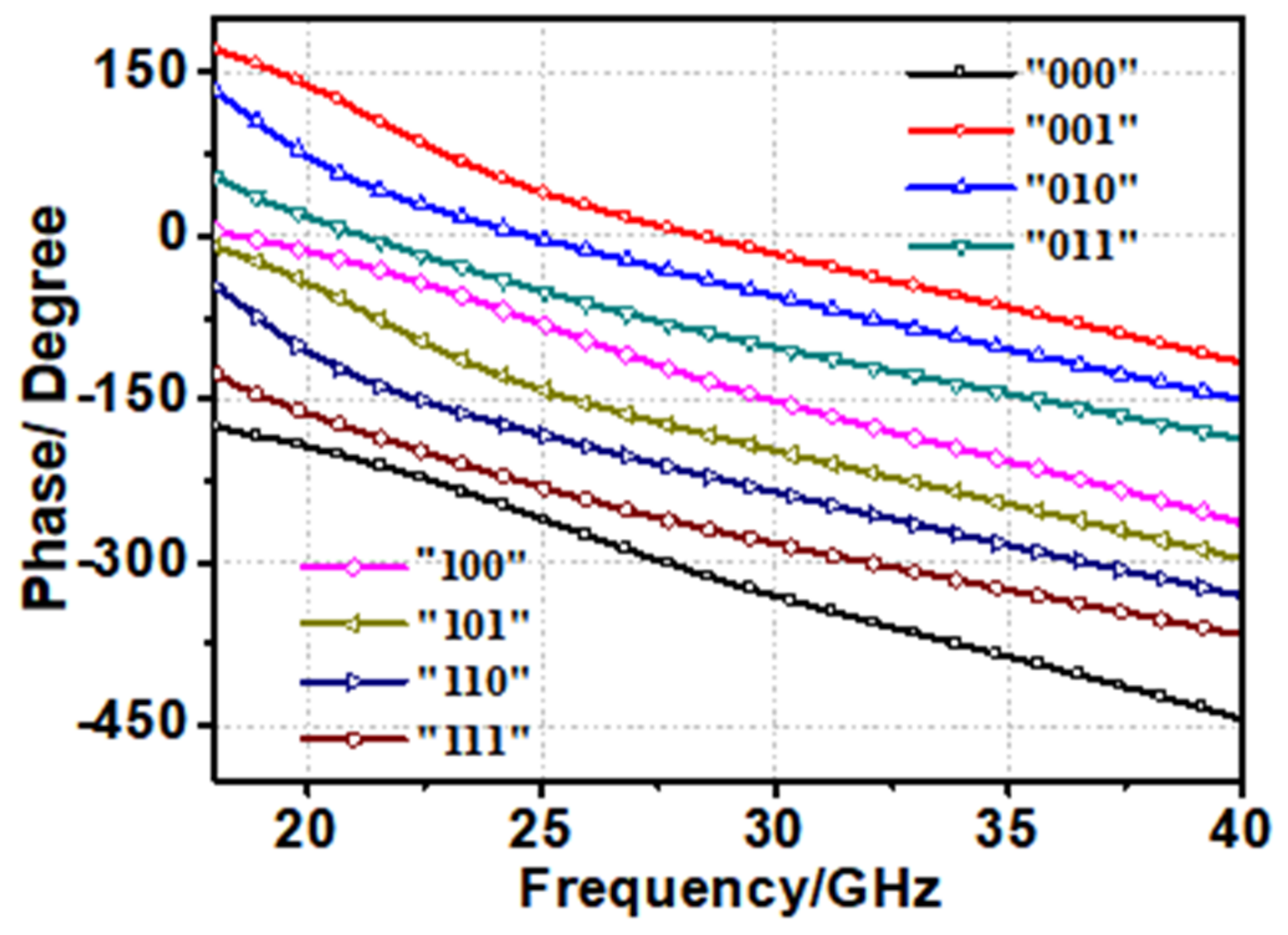
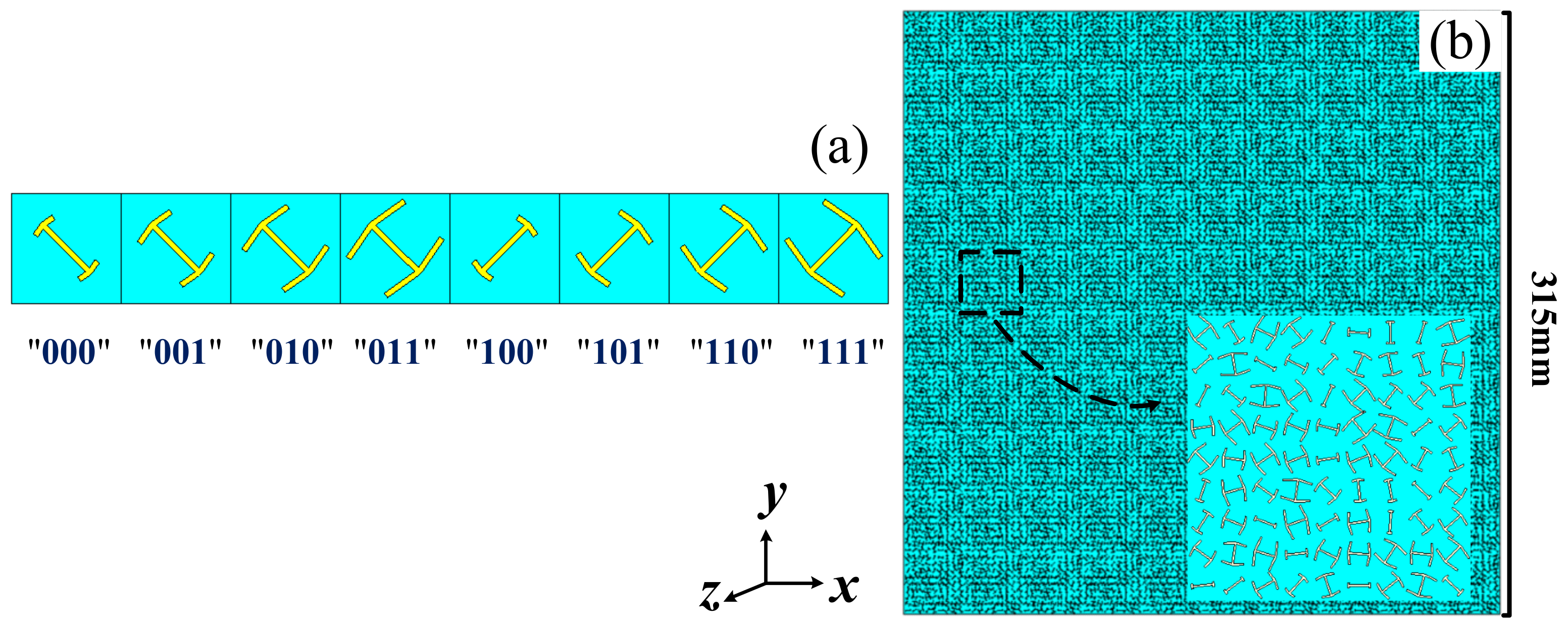


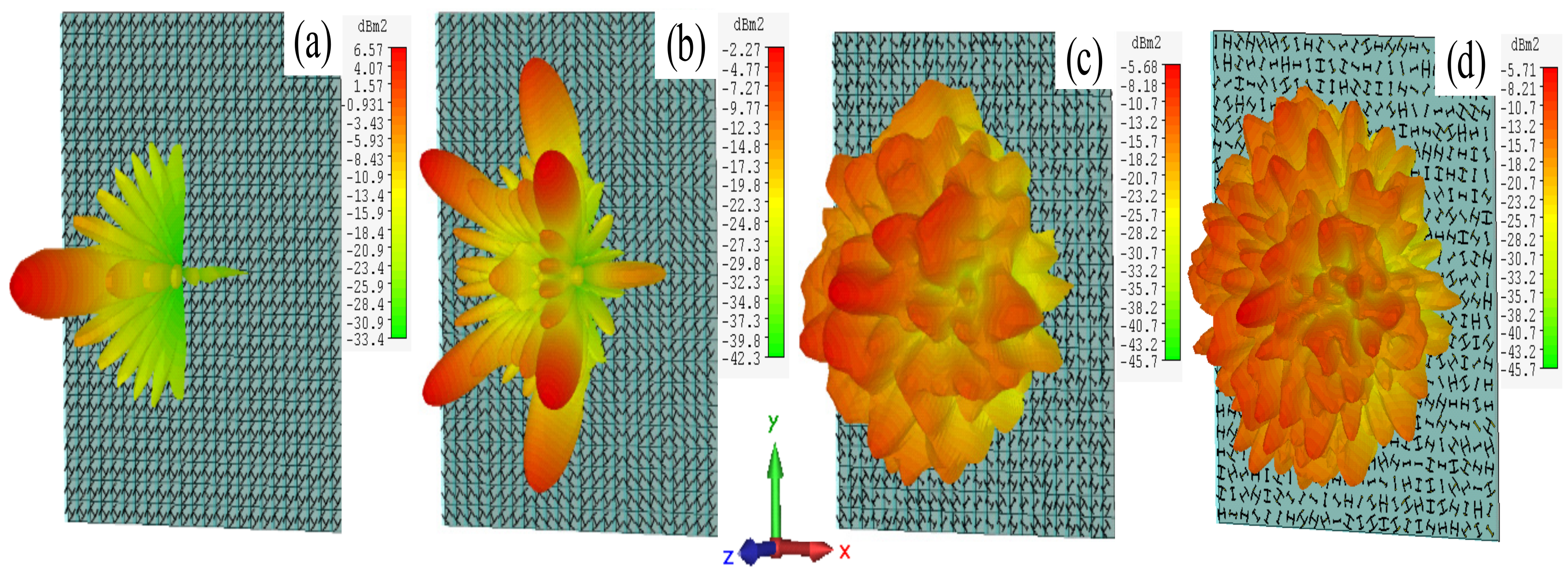

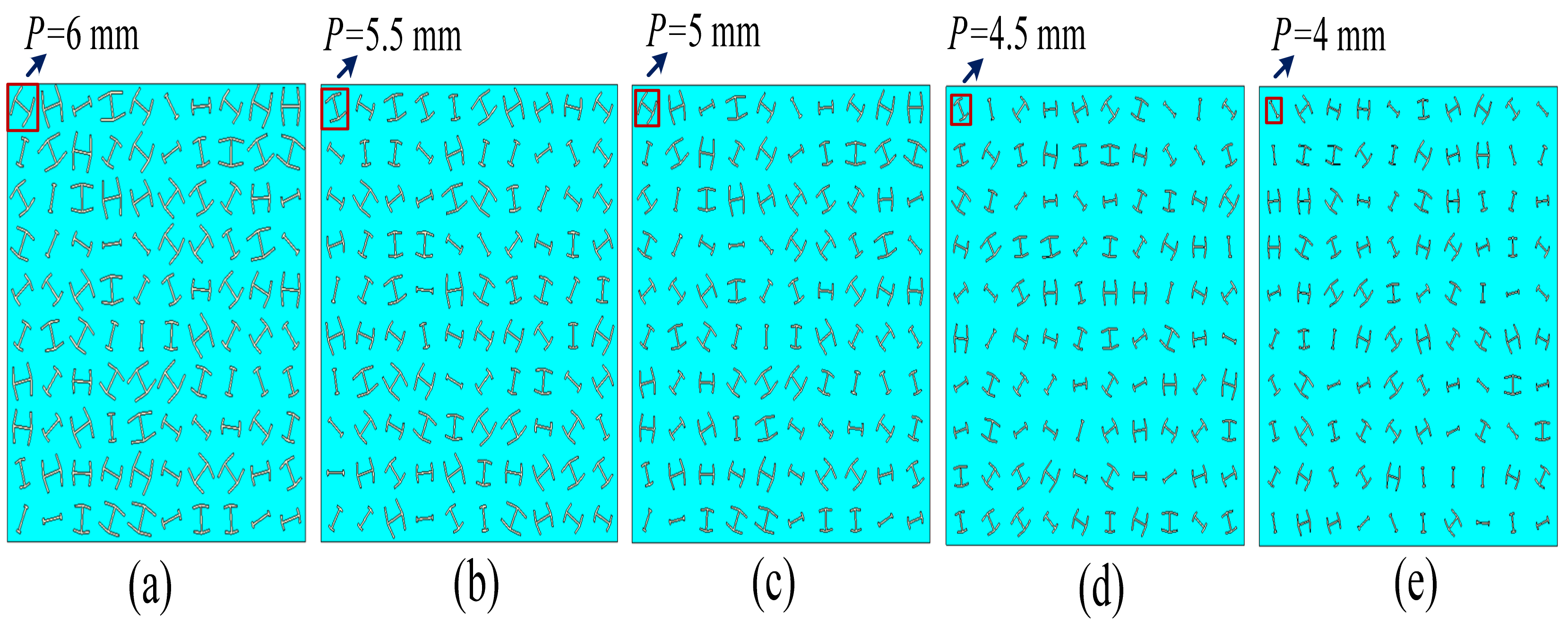





| OB (GHz) | RB (%) | d (mm) | p (mm) | |
|---|---|---|---|---|
| Ref. [29] | 10.6–17 | 49 | 3 | 10 |
| Ref. [28] | 12.4–27.96 | 77 | 1.6 | 6.4 |
| Ref. [26] | 6.3–20.1 | 95.7 | 1.5 | 10 |
| Present study | 14.4–48.5 | 108.4 | 1.5 | 4 |
© 2019 by the authors. Licensee MDPI, Basel, Switzerland. This article is an open access article distributed under the terms and conditions of the Creative Commons Attribution (CC BY) license (http://creativecommons.org/licenses/by/4.0/).
Share and Cite
Dai, H.; Zhao, Y.; Li, H.; Chen, J.; He, Z.; Qi, W. An Ultra-Wide Band Polarization-Independent Random Coding Metasurface for RCS Reduction. Electronics 2019, 8, 1104. https://doi.org/10.3390/electronics8101104
Dai H, Zhao Y, Li H, Chen J, He Z, Qi W. An Ultra-Wide Band Polarization-Independent Random Coding Metasurface for RCS Reduction. Electronics. 2019; 8(10):1104. https://doi.org/10.3390/electronics8101104
Chicago/Turabian StyleDai, Huijuan, Yongjiu Zhao, Huangyan Li, Jiaqing Chen, Zheng He, and Wenjun Qi. 2019. "An Ultra-Wide Band Polarization-Independent Random Coding Metasurface for RCS Reduction" Electronics 8, no. 10: 1104. https://doi.org/10.3390/electronics8101104
APA StyleDai, H., Zhao, Y., Li, H., Chen, J., He, Z., & Qi, W. (2019). An Ultra-Wide Band Polarization-Independent Random Coding Metasurface for RCS Reduction. Electronics, 8(10), 1104. https://doi.org/10.3390/electronics8101104




